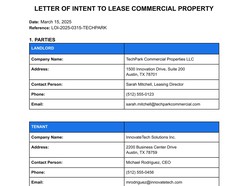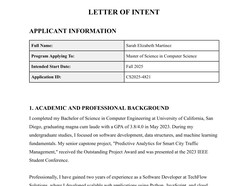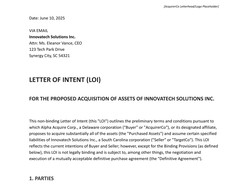This Google Docs template provides a structured framework for drafting a Letter of Intent (LOI) to lease commercial property. It outlines key terms and conditions, facilitating clear communication and negotiation between prospective tenants and landlords before a formal lease agreement is prepared.
Features:
- Comprehensive Sections: Includes all critical elements such as party identification, property details, lease term, rent, permitted use, tenant improvements, and binding/non-binding clauses.
- Professional Formatting: Designed with a modern, clean layout, utilizing clear headings, organized tables for financial details, and appropriate emphasis to enhance readability.
- Fully Editable: Easily customize all content, including sample data, to precisely match the specifics of your intended lease agreement.
- Google Docs Native: Seamlessly works within the Google Docs environment for easy access, collaboration, and sharing.
Who is this template for?
This template is ideal for business owners, entrepreneurs, real estate brokers, property managers, and legal professionals involved in commercial property leasing.
In what situations should it be used?
Utilize this template when initiating discussions for leasing office spaces, retail locations, industrial units, or other commercial real estate. It serves as a foundational document to express serious intent and agree upon principal terms before investing time and resources into drafting a full lease.
Format: Google Docs
How To Use This Template
Accessing and utilizing this Letter of Intent template is straightforward. Follow these guidelines to effectively create your document:
Making a Copy
A Google account is required to use and save this template.
Click the “Use template” button, typically located in the top right corner of the document preview page.
This action will automatically create a new, editable copy of the document directly in your personal Google Drive.
Customization Best Practices
Replace Placeholder Information: Diligently review every section and replace all sample data (e.g., names, addresses, dates, financial figures, square footage) with the specific details pertinent to your transaction.
Verify Accuracy: Double-check all entered information for precision, especially property descriptions, lease commencement and expiration dates, rent amounts, and calculations for operating expenses.
Tailor Specific Clauses: Pay particular attention to sections such as "Permitted Use," "Tenant Improvements," "Renewal Options," and any clauses explicitly stated as binding (e.g., "Confidentiality," "Exclusivity"). Modify these to accurately reflect the preliminary understanding between the parties.
Understand Non-Binding Nature: Remember that, unless specified otherwise for certain clauses, this Letter of Intent is generally non-binding. Its purpose is to outline terms for further negotiation and the drafting of a formal lease agreement. The template includes standard disclaimer language to this effect.
Seek Legal Review: While this template provides a comprehensive starting point, it does not constitute legal advice. It is highly recommended that both prospective landlords and tenants have the completed Letter of Intent reviewed by their respective legal counsel before signing. This step is crucial to ensure all terms are understood and protect individual interests.
Maintain Professionalism: Ensure all modifications uphold the document's professional tone and clarity. Avoid ambiguous language that could lead to misunderstandings during subsequent lease negotiations.










